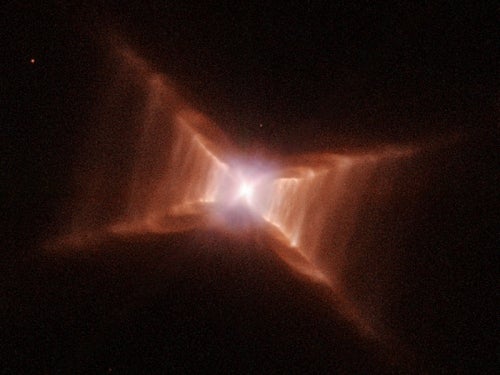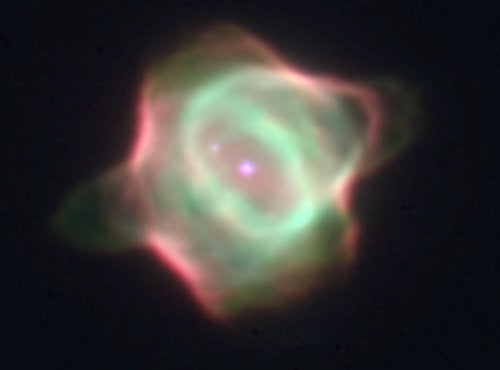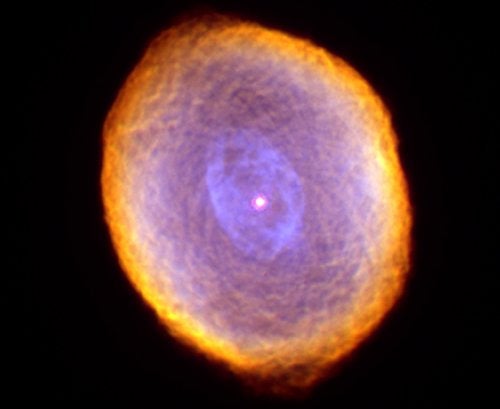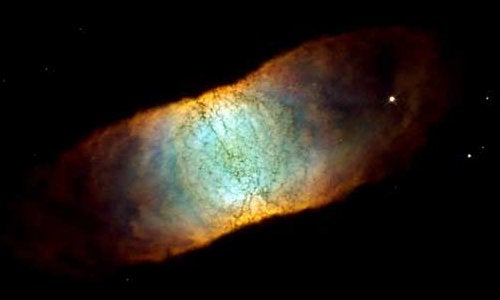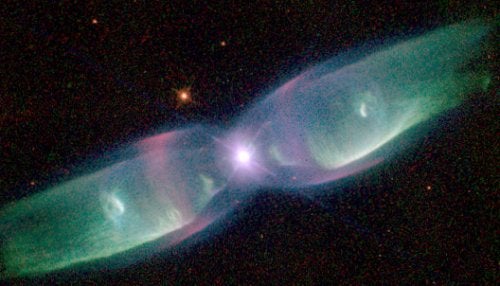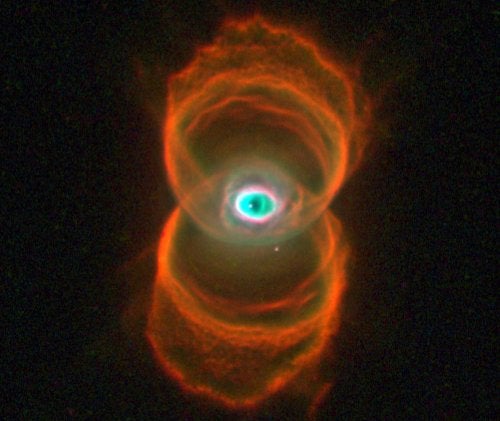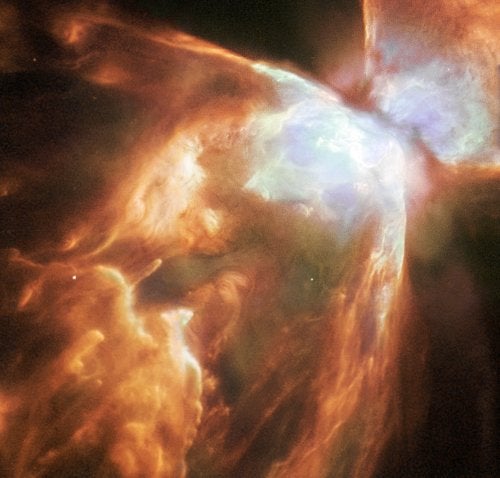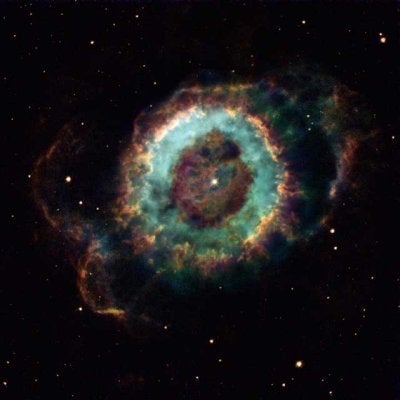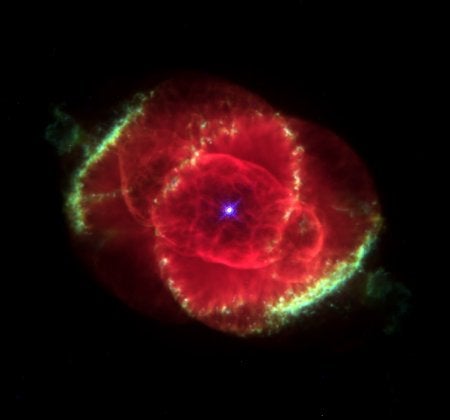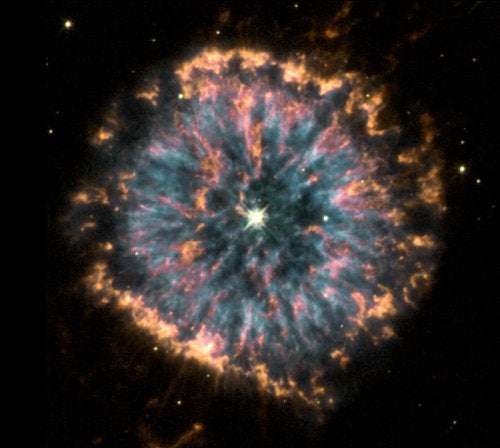The Red Rectangle (HD 44179)
The Red Rectangle (HD 44179) in the constellation Monoceros the Unicorn is a planetary nebula with ladder-like structures surrounding the central star.
The Red Rectangle (HD 44179) in the constellation Monoceros the Unicorn is a planetary nebula with ladder-like structures surrounding the central star.
The Stingray Nebula (Henize 1357)
The Stingray Nebula (Henize 1357) is the youngest known planetary nebula. It lies within the boundaries of the constellation Ara the Altar, approximately 18,000 light-years away.
The Stingray Nebula (Henize 1357) is the youngest known planetary nebula. It lies within the boundaries of the constellation Ara the Altar, approximately 18,000 light-years away.
The Spirograph Nebula (IC 418)
The Spirograph Nebula (IC 418) lies at a distance of 2,000 light-years in the constellation Lepus the Hare. Hubble revealed an unusual texture in the outer gas shell, but this is not yet well understood.
The Spirograph Nebula (IC 418) lies at a distance of 2,000 light-years in the constellation Lepus the Hare. Hubble revealed an unusual texture in the outer gas shell, but this is not yet well understood.
The Retina Nebula (IC 4406)
The Retina Nebula (IC 4406) in the constellation Lupus the Wolf is a planetary nebula with a high degree of symmetry. Notice how the left side of the object is nearly a mirror image of the right side. Crisscrossing the nebula’s center is a lattice of dark lanes, which lie at the boundary between the hot, glowing gas near the central star and the cooler, outer regions.
The Retina Nebula (IC 4406) in the constellation Lupus the Wolf is a planetary nebula with a high degree of symmetry. Notice how the left side of the object is nearly a mirror image of the right side. Crisscrossing the nebula’s center is a lattice of dark lanes, which lie at the boundary between the hot, glowing gas near the central star and the cooler, outer regions.
The Twin Jet Nebula (M 2–9) doesn’t look like a planetary nebula. Two lobes of material are being ejected from the region of the central star at speeds in excess of 200 miles (320 kilometers) per second. The Twin Jet Nebula lies 2,000 light-years away in the constellation Ophiuchus the Serpent Bearer.
NASA
The Twin Jet Nebula (M 2-9)
The Twin Jet Nebula (M 2-9) doesn’t look like a planetary nebula. Two lobes of material are being ejected from the region of the central star at speeds in excess of 200 miles (320 kilometers) per second. The Twin Jet Nebula lies 2,000 light-years away in the constellation Ophiuchus the Serpent Bearer.
The Twin Jet Nebula (M 2-9) doesn’t look like a planetary nebula. Two lobes of material are being ejected from the region of the central star at speeds in excess of 200 miles (320 kilometers) per second. The Twin Jet Nebula lies 2,000 light-years away in the constellation Ophiuchus the Serpent Bearer.
The Hourglass Nebula (MyCn18) is an intricately structured planetary nebula. The shape of this nebula may be produced by a fast stellar wind within a slowly expanding cloud. The Hourglass Nebula lies 8,000 light-years away and is located within the boundaries of the constellation Musca the Fly.
NASA
The Hourglass Nebula (MyCn18)
The Hourglass Nebula (MyCn18) is an intricately structured planetary nebula. The shape of this nebula may be produced by a fast stellar wind within a slowly expanding cloud. The Hourglass Nebula lies 8,000 light-years away and is located within the boundaries of the constellation Musca the Fly.
The Hourglass Nebula (MyCn18) is an intricately structured planetary nebula. The shape of this nebula may be produced by a fast stellar wind within a slowly expanding cloud. The Hourglass Nebula lies 8,000 light-years away and is located within the boundaries of the constellation Musca the Fly.
The Bug Nebula (NGC 6302)
The Bug Nebula (NGC 6302) in Scorpius is a well-known planetary nebula to amateur astronomers. It has a visual magnitude of 9.6 and lies 6,500 light-years away. Its double-lobed structure is a result of material flowing away in two directions from the hot central star.
The Bug Nebula (NGC 6302) in Scorpius is a well-known planetary nebula to amateur astronomers. It has a visual magnitude of 9.6 and lies 6,500 light-years away. Its double-lobed structure is a result of material flowing away in two directions from the hot central star.
This planetary nebula was discovered in the 18th century by William Herschel. Like other planetary nebulae, NGC 6369 was created at the end of a sunlike star’s life as the star’s outer layers expanded into space. The star’s core collapsed into a white dwarf, seen at the center of the nebula.
NASA / Hubble Heritage Team (STScI / AURA)
The Little Ghost Nebula (NGC 6369)
The Little Ghost Nebula (NGC 6369) is a planetary in Ophiuchus the Serpent Bearer. This object was named the Little Ghost by amateur astronomers because of its difficult-to-see outer shell of gas.
The Little Ghost Nebula (NGC 6369) is a planetary in Ophiuchus the Serpent Bearer. This object was named the Little Ghost by amateur astronomers because of its difficult-to-see outer shell of gas.
This Hubble Space Telescope image shows one of the most complex planetary nebulae ever seen, NGC 6543, nicknamed the “Cat’s Eye Nebula.” Hubble reveals surprisingly intricate structures including concentric gas shells, jets of high-speed gas, and unusual shock-induced knots of gas. The image was taken by Hubble’s Wide Field and Planetary Camera 2 on September 18, 1994.
J.P. Harrington and K.J. Borkowski (University of Maryland) / NASA
The Cat’s Eye Nebula (NGC 6543) is an 8th-magnitude planetary nebula that lies 3,600 light-years away in the direction of the constellation Draco the Dragon. It can be seen easily through 6-inch telescopes, but 12-inch and larger scopes reveal a wealth of detail.
Blue regions, forming a rough circular ring around the central stellar remnant, mark the hottest gas. Orange and red show the locations of cooler gas. The cool gas tends to lie in long streamers pointing away from the central star, and in a surrounding, tattered-looking ring at the outer edge of the nebula. The origin of these cooler clouds is still uncertain, but the streamers are clear evidence that their shapes are affected by radiation and stellar winds from the hot star at the center. The star’s surface temperature is approximately 140,000 degrees Celsius (250,000 degrees Fahrenheit).
AURA / STScI / NASA
NGC 6751
This image of NGC 6751 was released to commemorate Hubble’s 10th anniversary in April 2000. NGC 6751 is a large planetary nebula in the constellation Aquila the Eagle.
This image of NGC 6751 was released to commemorate Hubble’s 10th anniversary in April 2000. NGC 6751 is a large planetary nebula in the constellation Aquila the Eagle.

